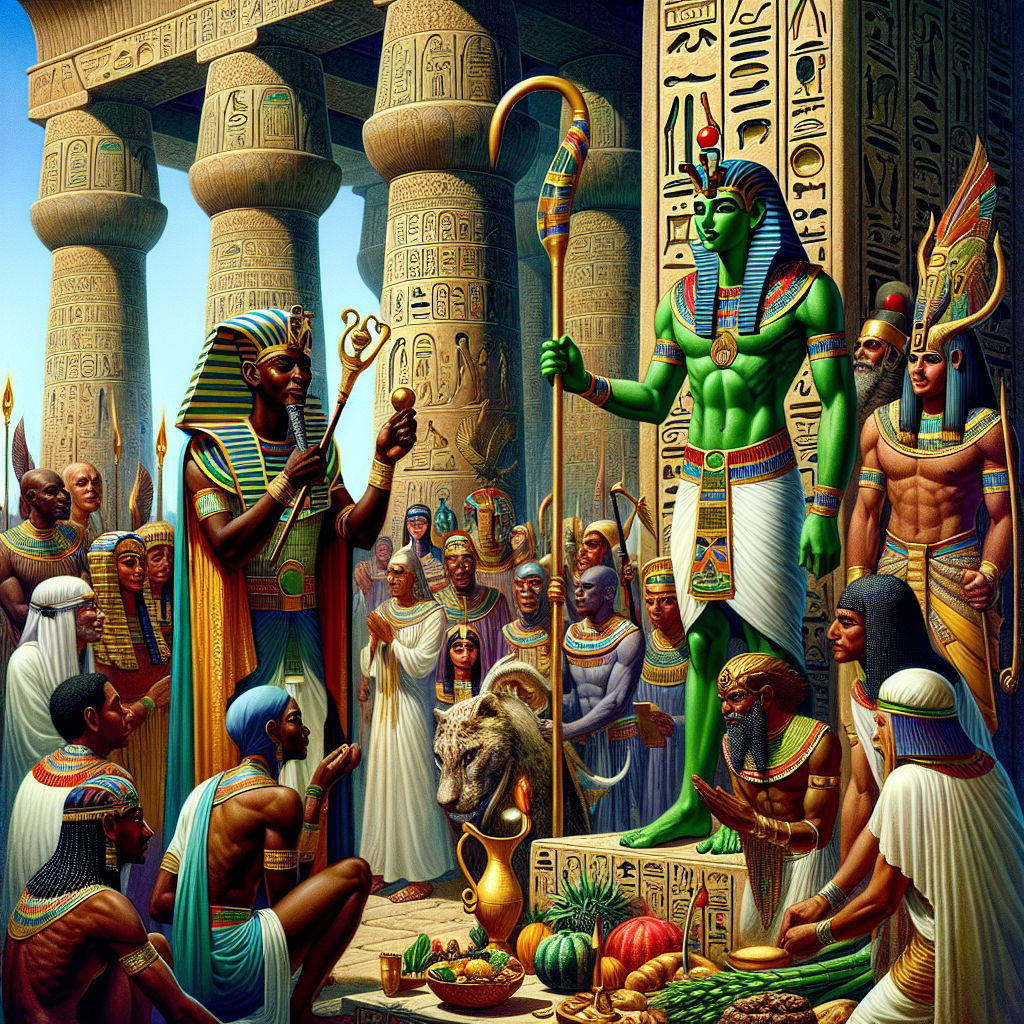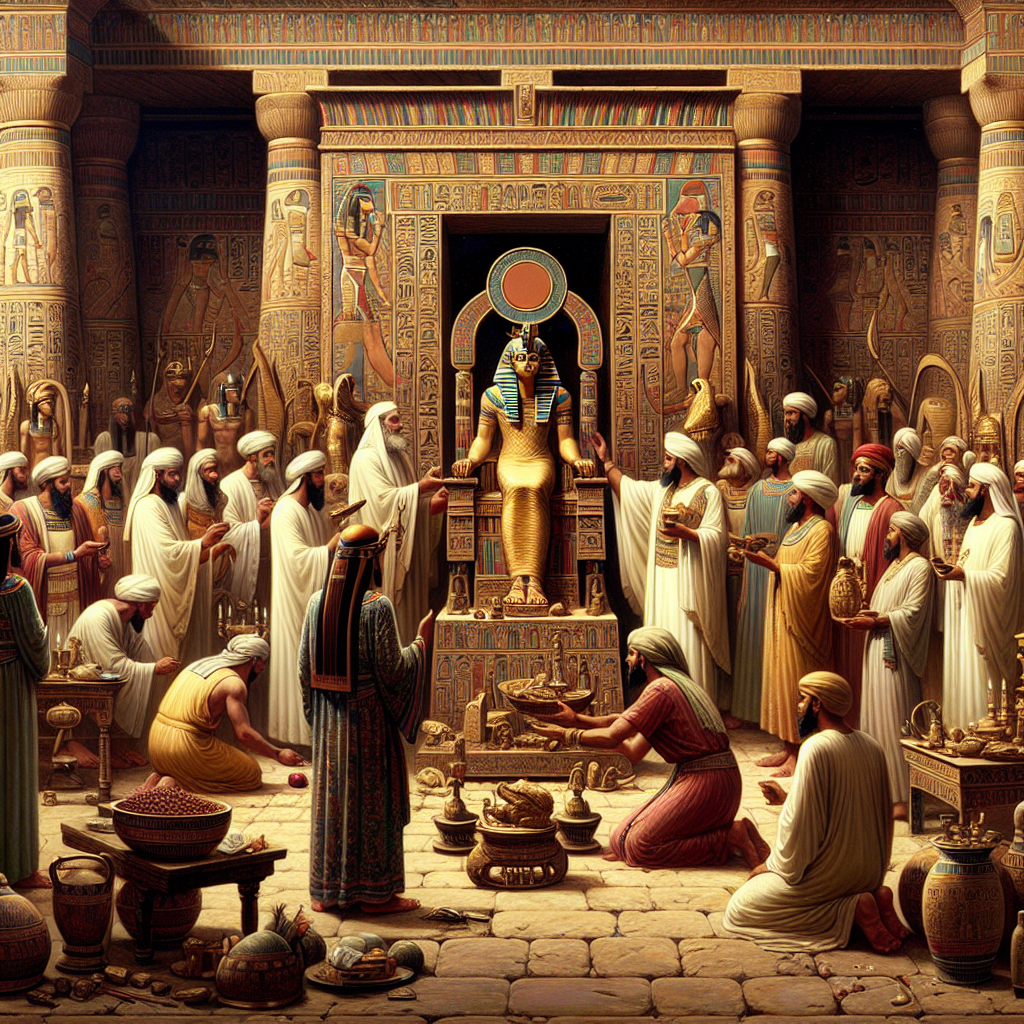As an Amazon Associate I earn from qualifying purchases.
↻
Last updated: December 24, 2025

Osiris, once a Pharaoh of Egypt, became the god of the afterlife, the underworld, and the dead in ancient Egyptian religion. His story is one of death and rebirth, making him a potent symbol of resurrection and eternal life. He is often depicted as a mummified king, holding the crook and flail symbols of rulership. After being murdered by his brother Set and then resurrected by his wife Isis, Osiris became the judge of the deceased in the afterlife, promising the faithful the possibility of eternal life.
The devotional practices to Osiris are steeped in millennia-old traditions where ancient Egyptians sought to align themselves with the god's regenerative powers. These beliefs and rituals formed an essential part of the Egyptian culture, articulating their understanding of mortality, the afterlife, and the cosmic order. Temples and tomans across the ancient Egyptian empire were adorned with inscriptions and images dedicated to Osiris, with the city of Abydos being at the center of his cult. Even today, the myth of Osiris inspires many people who search for meaning in life and death, drawing parallels to other cultural narratives of death and resurrection.
A particularly engaging element of the Osiris devotional practice involved the construction of small figurines, known as ushabti, which were placed in tombs among the grave goods. These statuettes were intended to serve as servants for the deceased in the afterlife, symbolizing the continuation of life's comforts beyond death. Interestingly, some tombs have been discovered with an ushabti for each day of the year, reflecting an extraordinary commitment to ensuring that the deceased would not lack assistance in the hereafter.
The Osiris myth encapsulates the ancient Egyptian's deep relationship with the Nile River, which they likened to the tears of Isis mourning Osiris. The Nile's annual flooding, which brought fertility to an otherwise arid land, was celebrated as a reflection of Osiris's power to bring life to the dead land. This cyclical event, so critical to the survival of the ancient Egyptians, further solidified the status of Osiris as a vital deity in their pantheon. Currently, researchers estimate that millions of artifacts related to Osiris's cult—including statues, amulets, and temple decorations—remain buried under the sands of Egypt, awaiting discovery. These relics promise to provide further insight into the complex web of ancient Egyptian ritual and belief.
Throughout history, the reverence for Osiris helped form a cohesive social and religious framework that survived for over three millennia in Egypt, one of the longest unbroken spiritual traditions in recorded history. As modern society grapples with its own perceptions of mortality and what lies beyond, the philosophies embedded within the Osiris mythos continue to resonate, illustrating an unbroken line of human contemplation and aspiration towards understanding the great mystery of life and death.
html
How Can the Osiris Devotional Aid in Understanding the Mysteries of Life and Death?
The Osiris Devotional, deeply rooted in ancient Egyptian spirituality, serves as a pivotal guide for those seeking to comprehend the profound mysteries of life and death through the lens of Osiris, the god of the afterlife, resurrection, and fertility. Embracing this devotion enables individuals to explore the cyclical nature of existence, the promise of rebirth, and the preparation for the afterlife, as Osiris exemplifies the eternal journey of the soul. By delving into this topic, one can gain insight into the rituals, prayers, and mythological narratives surrounding Osiris that have offered comfort and understanding across millennia. The following discussion will further unpack the significance of the Osiris Devotional and its enduring influence on concepts of mortality, eternal life, and spiritual rebirth.
Osiris Devotional for Life and Death
The osiris devotional practice is intrinsically linked to the ancient Egyptian deity Osiris, who embodied the concepts of life, death, and fertility. Osiris was worshipped as the god of the afterlife and was a key figure in the religious beliefs of ancient Egyptians. Known as the judge of the dead and the embodiment of the resurrection, Osiris played a central role in the myths and rituals that dealt with life beyond death.
In ancient Egyptian society, devotional acts dedicated to Osiris were carried out with the hope of securing a favorable afterlife. Devotees of Osiris would perform rituals, offer prayers, and present offerings, including flowers, food, and statuettes. These acts of veneration were conducted by both the elite and the common people, indicating the widespread adherence to the Osirian cult.
In terms of daily devotional practices, followers of Osiris observed festivals like the Khoiak Festival, a month-long celebration that consecrated the death and rebirth narrative of Osiris. During this period, Osiris gardens, which were essentially model tombs made of soil and grain, were sown and nurtured by believers as symbols of regrowth and rebirth.
The Osiris myth, illustrating his murder by his brother Set, his resurrection by his wife Isis, and his subsequent rule over the underworld, played a major role in how ancient Egyptians approached the concept of life after death. Osiris became synonymous with the rebirth of the soul and this narrative offered solace and hope to his followers.
Artifacts and temple inscriptions provide evidence of how the living sought to align themselves with Osiris in the hope of sharing in his rebirth. The Book of the Dead, for example, contains spells intended to aid and protect souls in the afterlife, many of which invoked Osiris' power.
The prominence of Osiris extended to the burial customs of the Egyptians. Pharaohs and commoners alike sought to emulate Osiris in death, adopting the “Osiris pose,”—mummified with arms crossed over the chest—and even referring to themselves as Osiris in their tomb inscriptions.
The significance of Osiris in matters of life and death was such that it persisted well into the Greco-Roman period. Even today, the figure of Osiris continues to be a subject of fascination, his myth symbolizing the eternal cycle of life, death, and rebirth.
In modern times, osiris devotional acts may not be as widespread, but the interest in Egyptian mythology and the reverence for ancient practices persists. Contemporary spiritual practitioners who align with eclectic or Egyptian-revivalist paths may still perform rituals and offer devotions to Osiris as a way of connecting with the powerful themes of life, death, and afterlife that he represents.
Indeed, the allure of Osiris has transcended the original geographic and temporal boundaries of ancient Egypt, with his story continuing to inspire art, literature, and religious thought across the world. According to a 2020 survey on world mythologies, the Osiris myth remains one of the most recognized and influential mythic narratives, showcasing the enduring legacy of this ancient god of life and death.
- What is Osiris devotion and how is it performed?
Osiris devotion is a spiritual practice that honors Osiris, the ancient Egyptian god of the afterlife, death, life, and resurrection. It is performed through prayers, offerings, meditations, and sometimes rituals that align with the mythology and attributes associated with Osiris.
- Can anyone practice Osiris devotion, or is it limited to those of a particular faith or background?
While Osiris devotion stems from ancient Egyptian beliefs, it can be practiced by anyone who feels drawn to Osiris regardless of their faith or background. Respecting the origins and traditions associated with Osiris is crucial when incorporating this practice into your spiritual path.
- What are typical offerings made to Osiris during devotional practices?
Typical offerings to Osiris may include bread, beer, green herbs (symbolizing vegetation and rebirth), incense, and prayers. The offerings should be made with respect and intent, reflecting Osiris's association with life, fertility, and resurrection.
- How often should one perform Osiris devotional practices?
The frequency of Osiris devotional practices is a personal choice and can depend on individual intent, tradition, or the significance of certain days related to Osiris and the Egyptian calendar. Daily, weekly, or periodic devotionals can all be effective.
- Is there a specific time of day that is best for Osiris devotionals?
There is no specific time of day prescribed for Osiris devotionals. However, some practitioners prefer sunrise, symbolizing rebirth and new beginnings, or sunset, reflecting the journey into the afterlife and the realm of Osiris.
- Are there any particular mantras or prayers used in Osiris devotionals?
Yes, there are ancient Egyptian prayers and hymns dedicated to Osiris found in texts like the Pyramid Texts and the Coffin Texts. Modern devotees might also create personal prayers or mantras that reflect their understanding and relationship with Osiris.
- What is the significance of the Djed pillar in Osiris worship?
The Djed pillar represents stability, strength, and resurrection, all of which are attributes associated with Osiris. It is often included in devotional practices as a symbol of Osiris's enduring presence and the devotee's desire for these qualities in their life.
- Can Osiris devotionals be incorporated into a group ritual, or are they strictly solitary?
Osiris devotionals can be adapted for both solitary practice and group rituals. The key is to ensure that all participants share a sense of reverence and purpose when honoring Osiris together.
- How can one create a sacred space for Osiris devotionals?
Creating a sacred space for Osiris devotionals involves setting aside an area that is clean, quiet, and respectful. It may be decorated with symbols related to Osiris, such as the Djed pillar, flail and crook, and images or statues of the deity, along with space for offerings.
- Is it important to study ancient Egyptian mythology and culture to practice Osiris devotionals?
While not strictly necessary, having an understanding of ancient Egyptian mythology and culture can deepen the practice of Osiris devotionals. It provides context, enriches the spiritual experience, and ensures practices are conducted with respect for their historical and cultural origins.

Conclusion
The Osiris Devotional for Life and Death provides a profound reflection on the enduring legacy of Osiris as both a deity of the afterlife and a symbol of rebirth. Central to the insights shared is the understanding of Osiris as an embodiment of the cycle of life, death, and renewal, which resonates deeply within the human psyche. The devotional practices surrounding Osiris, including offering rituals, prayers, and the emulation of his myth through various rites, serve not only to honor the god but also to facilitate a connection between the practitioner and the powerful forces of regeneration that Osiris represents. Through these devotions, followers seek to align themselves with the divine order and the promise of life after death.
Additionally, the article underscores the influence of Osiris on concepts of morality and justice in the afterlife as evidenced by the weighing of the heart ceremony, where the dead were judged based on their earthly deeds. This aspect of the Osiris devotion emphasizes the integration of ethical conduct with spiritual belief, encouraging adherents to live a life of virtue in preparation for the afterlife. The enduring popularity of Osirian worship throughout ancient Egypt and its ability to adapt and integrate with various cultural changes highlights its profound impact on both personal spirituality and societal values. Ultimately, the Osiris Devotional for Life and Death brings to light the multifaceted ways in which the veneration of Osiris contributed to ancient Egyptian conceptions of immortality and the human quest for meaning in the face of mortality.
Amazon and the Amazon logo are trademarks of Amazon.com, Inc, or its affiliates.
Continue Your Magical Journey
Free Witchcraft Starter Kit
Get 6 free printable PDFs: grimoire pages, moon calendar, spells, crystals, herbs, and tarot journal.
We respect your privacy. Unsubscribe anytime.
Enhance Your Practice
As an Amazon Associate, I earn from qualifying purchases.

